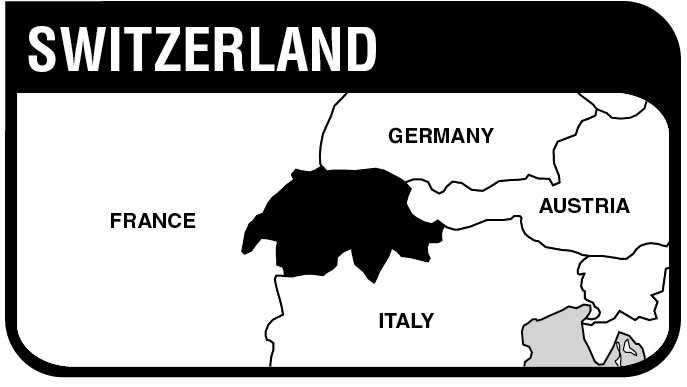

The Swiss Confederation, located in central Europe north of Italy and south of Germany, has an area of 15,941 sq. mi. (41,290 sq. km.) and a population of *6.6 million. Capital: Bern. The economy centers about a well developed manufacturing industry. Machinery, chemicals, watches and clocks, and textiles are exported.
Switzerland, the habitat of lake dwellers in prehistoric times, was peopled by the Celtic Helvetians when Julius Caesar made it a part of the Roman Empire in 58 B.C. After the decline of Rome, Switzerland was invaded by Teutonic tribes, who established small temporal holdings which in the Middle Ages, became a federation of fiefs of the Holy Roman Empire. As a nation, Switzerland originated in 1291 when the districts of Nidwalden, Schwyz and Uri united to defeat Austria and attain independence as the Swiss Confederation. After acquiring new cantons in the 14th century, Switzerland was made independent from the Holy Roman Empire by the 1648 Treaty of Westphalia. The revolutionary armies of Napoleonic France occupied Switzerland and set up the Helvetian Republic, 1798-1803. After the fall of Napoleon, the Congress of Vienna, 1815, recognized the independence of Switzerland and guaranteed its neutrality. The Swiss Constitutions of 1848 and 1874 established a union modeled upon that of the United States.
Model 1872
This Swiss Model 1872 is a 10.4mm rimfire revolver with a 6-shot fluted cylinder. It is fitted with a 5.9-inch octagon barrel. The frame is solid with fixed fluted cylinder and mechanical rod ejection. Checkered wood grips with lanyard loop. The revolver was built by the Belgian firm of Pirlot Freres in Liege. It was issued from 1872 until 1878. Weight is 37 oz. This was the last foreign-built handgun to be issued to the Swiss military.
NOTE: This is a very rare revolver as most were converted to centerfire with the Model 1872/78 in 1878.

Courtesy Geschichte und Technik der europaischen Militarrevolver, Journal-Verlag Schwend GmbH with permission
Exc. |
V.G. |
Good |
Fair |
N/A |
— |
— |
— |
Model 1872/78
This is a centerfire converted Model 1872 in 10.4mm. This revolver was rarely used by the Swiss military.

Courtesy Geschichte und Technik der europaischen Militarrevolver, Journal-Verlag Schwend GmbH with permission
Exc. |
V.G. |
Good |
Fair |
1500 |
— |
— |
— |
Model 1878
This was the first Swiss-made revolver used by the Swiss military. Made in Bern, this Schmidt-Galand-type revolver was chambered for the 10.4mm cartridge. The frame was solid with fixed cylinder and mechanical rod ejection. 4.5-inch octagon barrel. Checkered grips with the Swiss cross on the left side. Weight was about 35 oz. This revolver was issued to cavalry units with about 6,000 in service.
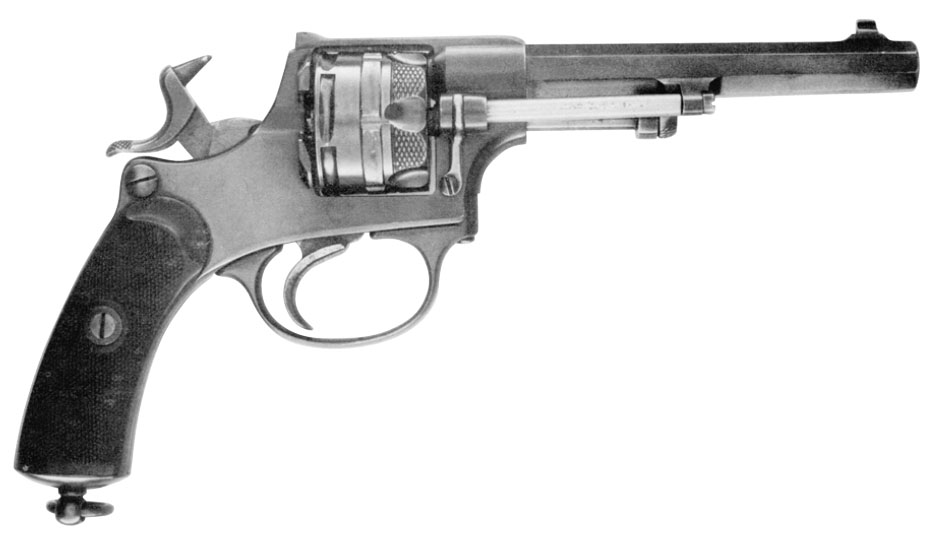
Courtesy Geschichte und Technik der europaischen Militarrevolver, Journal-Verlag Schwend GmbH with permission
Exc. |
V.G. |
Good |
Fair |
1750 |
1000 |
600 |
350 |
Model 1882
This revolver was similar in appearance to the Model 1878 but was chambered for the smaller 7.5mm cartridge. It was fitted with a 4.5-inch octagon barrel. Early Model 1882 revolvers were fitted with hard rubber checkered grips while later guns will be seen with grooved wooden grips. This revolver was built in Switzerland at Bern or SIG. Weight is about 27 oz. This model stayed in use in the Swiss military from 1882 to as late as 1950.

Right side of the Model 1882 Swiss revolver • Courtesy Rock Island Auction Company
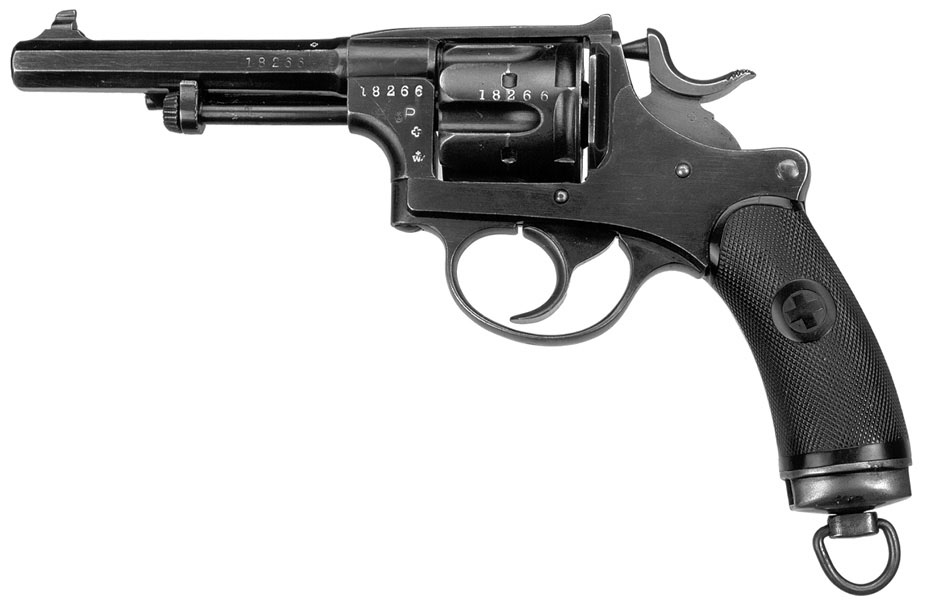


Exc. |
V.G. |
Good |
Fair |
1250 |
850 |
500 |
300 |
Model 1929
This is a solid frame double action revolver that is gate loaded. The round barrel is 4.5 inches long. Chambered for the 7.5×23R Swiss revolver cartridge. The fluted cylinder holds 6 rounds. Checkered bakelite grips. Weight is about 28 ozs. The grip on the Model 1929 is of a different shape than the Model 1882.
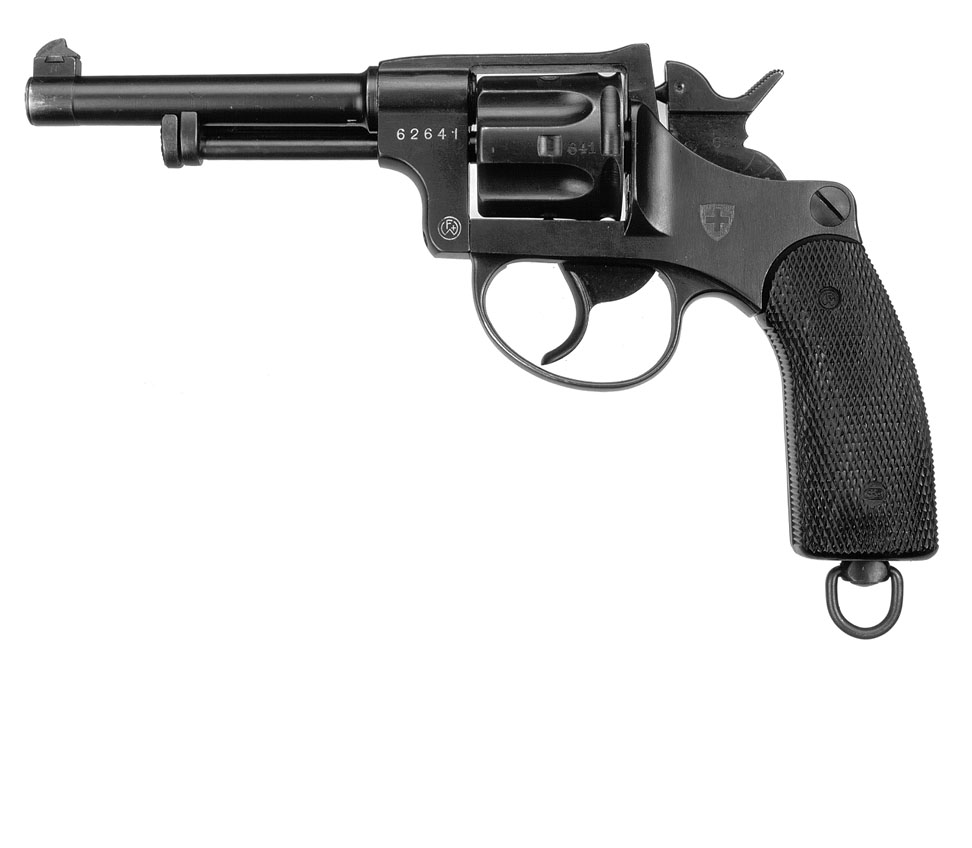

Model 1929 Swiss revolver • Courtesy Daniel Rewers collection,
Paul Goodwin photo
Exc. |
V.G. |
Good |
Fair |
1250 |
850 |
500 |
300 |
WAFFENFABRIK BERN
Switzerland was the first country to adopt the Luger as a military sidearm with its contract purchase of the Model 1900 from DWM. Another contract for the Model 1906 soon followed. Because DWM could no longer supply Switzerland with Lugers during WWI, the Swiss firm of Waffenfabrik Bern (W+F Bern) produced its own version based on the Model 1906.
Bibliographical Note: For additional historical information, technical data, and photos, see Vittorio Bobba, Parabellum: A Technical History of Swiss Lugers, Italy, 1996.
NOTE: There are a number of sub-variations of Swiss Lugers that may affect value. It is strongly suggested that thorough research of this model be undertaken prior to a sale.
Model 1906 Bern
A Swiss-made copy of the German Model 1906 Luger. Made in caliber 7.65mm, fitted with a 4.75-inch barrel, and marked “WAFFENFABRIK BERN” under the Geneva cross on top of the toggle. The grips on this pistol are unique in that most are checkered walnut with a plain border on the front and rear edges. About 17,000 of these pistols were manufactured. This model was most likely produced between 1918 and 1933, and was built for the Swiss military.

Courtesy James Rankin
Exc. |
V.G. |
Good |
Fair |
3800 |
3000 |
2000 |
1200 |

Courtesy James Rankin
Model 1929
Similar to the above, with the exception that the toggle finger pieces are smooth, the grip frame is uncurved, safety lever is a flat configuration, and the grip safety is of inordinate size. Fitted with plastic grips. Chambered for caliber 7.65mm. About 30,000 of these pistols were produced. Sold both for military and commercial use.
Exc. |
V.G. |
Good |
Fair |
3250 |
2000 |
1500 |
1000 |

Swiss Luger magazine with script “P” marking on back. Price 150-75
Schweizerische Industrie Gesellschaft,
Neuhausen am Rheinfalls, Switzerland
BIOGRAPHICAL NOTE: For historical background, technical data, and photos, see Lorenz Vetter, Das grosse Buch der SIG-Pistolen, Verlag Stocker-Schmid AG, 1995.
NOTE: The P210 pistol was designated the SP47/8 prior to 1957, when it was renamed the P210. There are a number of production changes on this pistol that follow a chronological order.
P210
A 7.65mm or 9mm semi-automatic pistol with a 4.75-inch barrel and 8-shot magazine. Fixed rear sight. Blued with plastic grips. In 1996 the 9mm version was the only one imported. Weight is about 32 oz. This model was also used by the Danish army (Model 49).
NIB |
Exc. |
V.G. |
Good |
Fair |
2500 |
1500 |
1300 |
1100 |
800 |
NOTE: For 1996, a .22 caliber conversion unit serialized to the gun was available. Add $600 for this option.
P210-1
As above, with an adjustable rear sight, polished finish, and walnut grips. Imported prior to 1987. Weight is about 31 oz.
NIB |
Exc. |
V.G. |
Good |
Fair |
2750 |
2250 |
1500 |
1150 |
800 |
P210-2 (Swiss Army Model 49-SP47/8)
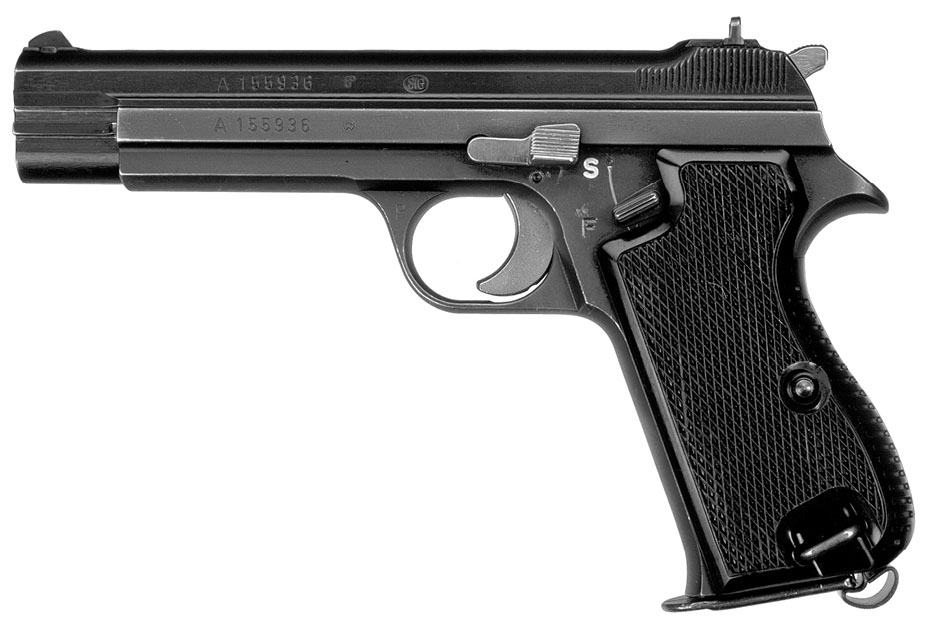
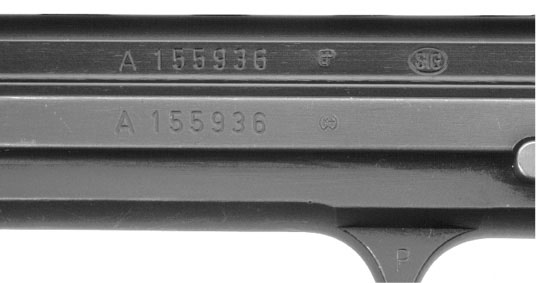
A Swiss P 49 military version of the P210. Note the Letter prefix on the serial number; a military designation • Courtesy Simon Stoddard collection, Paul Goodwin photo
This model is similar to the P210-1 with the exception that it has a sandblasted matte finish and black plastic grips with fixed sights. Adopted by the Swiss army in 1947 and still in service.
NIB |
Exc. |
V.G. |
Good |
Fair |
1800 |
1500 |
1350 |
1000 |
750 |
P210-3
Introduced in 1950, this model was issued to the Swiss police in Lausanne and Basel. Early examples are polished blue and later examples are sandblasted matte blue. Fixed sights. Production ceased in 1983. Very few of these pistols were sold on a commercial basis. Very scarce.
NIB |
Exc. |
V.G. |
Good |
Fair |
N/A |
— |
— |
— |
— |
P210-4
Special model produced for the West German Border Police. Fixed rear sight. Walnut grips on early models and black plastic grips on later models. Early models have blued finish while later models have sandblasted matte finish.
NIB |
Exc. |
V.G. |
Good |
Fair |
2250 |
1750 |
1350 |
1000 |
750 |
P210-5
A commercial version as above, with an extended length barrel of 5.9 (150mm) or 7.1 inches (180mm), adjustable rear sight, target trigger, and walnut grips. Front sight is fitted to front of extended barrel, not the slide. Offered in a standard and heavy frame weight. Polished blue finish. Weight is about 35 oz. for standard weight frame.
NIB |
Exc. |
V.G. |
Good |
Fair |
3000 |
2500 |
1750 |
1200 |
800 |
P210-6
A commercial version as above, with a 4.75-inch barrel. Front sight is fitted to slide. Adjustable rear sight on some of these variations, fixed sight on others. Polished blue finish.

SIG P210-6 Commercial Version • Courtesy SIGARMS
NIB |
Exc. |
V.G. |
Good |
Fair |
2000 |
1750 |
1500 |
1250 |
800 |
P210-7
This model is chambered for the .22 rimfire cartridge and fitted with a 4.75-inch barrel. Most of the variations of this model are built for commercial and export sales except one variation, which was built for the West German Border Guards as a practice pistol. Fixed sights. Checkered plastic grips.
NIB |
Exc. |
V.G. |
Good |
Fair |
Poor |
N/A |
— |
— |
— |
— |
— |
P220-P225 (Swiss Army Model P-75)
Swiss army military sidearm. This is a high-quality, double action semi-automatic pistol chambered for .38 Super, .45 ACP, and 9mm Parabellum. It has a 4.41-inch barrel and fixed sights and features the decocking lever that was found originally on the Sauer Model 38H. There are two versions of this pistol: one with a bottom magazine release (commonly referred to as the European model) and the other with the release on the side (commonly referred to as the American model), as on the Model 1911 Colt. The frame is a lightweight alloy that is matte finished and is available in either blue, nickel, or K-Kote finish with black plastic grips. The .45 ACP magazine capacity is 7 rounds and the pistol weighs 25.7 oz.; the .38 Super magazine capacity is 9 rounds and the pistol weighs 26.5 oz.; the 9mm magazine holds 9 rounds and the overall weight is 26.5 oz. This model was manufactured from 1976 and is still in production. The 9mm version in this model is no longer in production. The prices listed below are for guns with a standard blue finish.

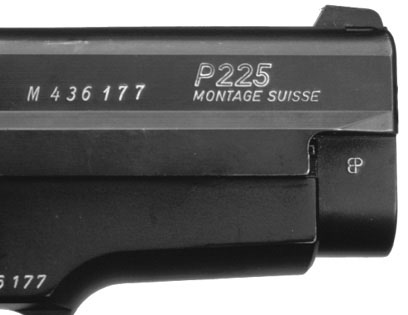
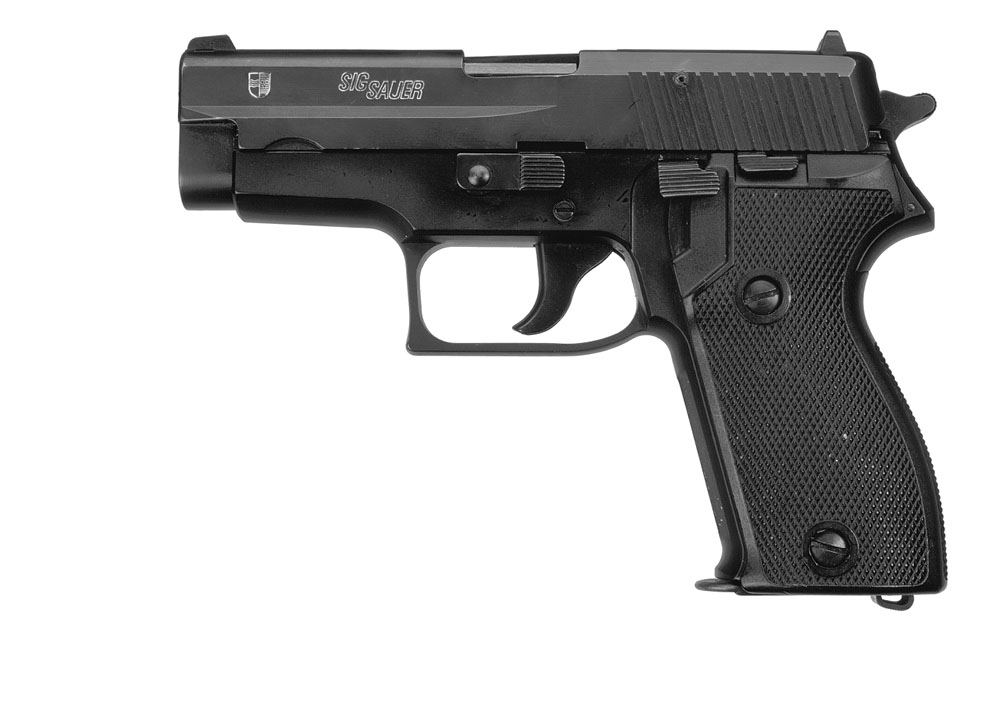

Swiss issue P225 with close-up of markings • Courtesy Danile Rewers collection, Paul Goodwin photo
NIB |
Exc. |
V.G. |
Good |
Fair |
750 |
550 |
400 |
300 |
200 |
NOTE: For the K-Kote finish add $40, for nickel slide add $40.
Steyr-Solothurn (Solothurn SI-100 or MP34[o])
See Austria, Submachine Guns, Steyr.
MP41/44
This model was developed by Furrer and built by W+F Bern arsenal between 1936 and 1942. Chambered for the 9mm Luger cartridge. Recoil operated with a toggle system similar to the Luger pistol but turned on its side. Slotted barrel jacket with 10-inch barrel with forward vertical handgrip and pistol grip wooden stock. Rate of fire is about 900 rounds per minute. Magazine capacity is 40 rounds. Very expensive to produce with the result that fewer than 5,000 guns were manufactured. Weight is about 11.5 lbs.

Swiss MP41 • Courtesy private NFA collection, Paul Goodwin photo
Pre-1968 (Rare)
Exc. |
V.G. |
Fair |
19500 |
18500 |
18000 |
MP43/44
The Swiss version of the Suomi with a bayonet lug and flip over rear sight. Built by Hispano Suiza under license from Finland. Rate of fire is about 800 rounds per minute and weight is approximately 10.5 lbs. Magazine capacity is 50-round box type.

Swiss M43/44 • Courtesy private NFA collection, Paul Goodwin photo

Pre-1968 (Rare)
Exc. |
V.G. |
Fair |
19500 |
19000 |
18000 |
Swiss Pre-Cartridge Era Rifles
Model 1842 Percussion Musket
Total length 58 inches. 42.5-inch barrel. Caliber 18mm. 3 bands.
Exc. |
V.G. |
Good |
Fair |
Poor |
2000 |
1400 |
950 |
500 |
300 |
Model 1842/59
The Model 1842 with a replacement 36-inch barrel with a new type of rifling.
Exc. |
V.G. |
Good |
Fair |
Poor |
2200 |
1600 |
1100 |
700 |
350 |
Model 1851 Federal Percussion Carbine
Total length 49.6 inches with a 32-inch barrel. Caliber .41/10.4mm. Features double set triggers and a stutzen style butt plate.
Exc. |
V.G. |
Good |
Fair |
Poor |
2000 |
1450 |
900 |
600 |
350 |
Model 1863 Percussion Rifle
Similar to the M1842/59 but in 10.5mm.
Exc. |
V.G. |
Good |
Fair |
Poor |
2500 |
1700 |
1250 |
650 |
350 |
Model 1867 Milbank-Amsler Rifle
A conversion of the M1851, 1859 and 1863 rifles to breech loading cartridge. Forward hinge trapdoor system similar to the U.S. M 1873. Both the 18mm and 10.4mm rifles were converted. Add 25% for 18mm version.

Exc. |
V.G. |
Good |
Fair |
Poor |
2600 |
1800 |
1250 |
800 |
400 |
Swiss Rifle (1867)
Chambered for the .41 Swiss rimfire cartridge, this rifle was fitted with a 31.625-inch barrel. Full stock with two barrel bands. The barrel is blued and the furniture casehardened. On the left side of the receiver are a cross and “W” inside an oval. “Peabody” stamped on left side of receiver. About 15,000 rifles were sold to the Swiss. Serial number range: 5500 to 21000.
Exc. |
V.G. |
Good |
Fair |
1500 |
1250 |
750 |
600 |
This rifle was invented by Friderich Vetterli at Neuhausen, Switzerland, in 1867. This was the first bolt action repeating rifle to be used as a military service weapon. It was adopted on January 8, 1869, and predated the Fruwirth by three years. It is chambered for the .41 Swiss rimfire cartridge (10.4mm). It has a 12-round tubular magazine that is loaded through a side gate similar to a Winchester lever action. There is a swinging cover on the loading gate. The finish is blue, with a full-length walnut stock secured by one barrel band and an endcap. There is a full-length cleaning rod located under the barrel. The receiver has a round configuration and the trigger guard has a rear spur. The rifle and its variations were built between 1869 and 1881.
Model 1869 Infantry Rifle
The first production model of the Vetterli series was made by nine contractors:
Barrel length is 33 inches. Cleaning rod. A swing-down loading gate is on the right side of the receiver. Magazine capacity is 12 rounds. Weight is about 10.25 lbs. Price is for an original Model 1869 with loading gate cover and magazine cut off.
Exc. |
V.G. |
Good |
Fair |
900 |
750 |
500 |
350 |
Model 1870 Cadet Rifle
Same action as the Model 1869 but single shot only. Barrel length is 26.75 inches. Weight about 7 lbs.

Bayonet for Vetterli M 1871



Model 1878 Sharpshooter • Private collection, Paul Goodwin photo
Exc. |
V.G. |
Good |
Fair |
900 |
750 |
500 |
350 |
Model 1869/71 Rifle
This rifle is fitted with a 33-inch barrel. Sights calibrated from 200 to 1,000 meters. Magazine capacity is 11 rounds. Weight is about 10.25 lbs. Most model 1869 Vetterlis were converted to this pattern by removal of the loading gate cover and magazine cut off.

Paul Goodwin photo
Exc. |
V.G. |
Good |
Fair |
400 |
300 |
250 |
150 |
Bayonet for Vetterli M1871
Socket type. 19-inch quadrangular blade. Opening at the rear of socket has a triangular slot to clear the front sight. Price range 150 – 85.
Model 1871 Stuzer (Short Rifle) (Sharpshooter)
This short rifle was fitted with two barrel bands on its 30-inch barrel. 9-round magazine. Fitted with a curved buttplate. Double set trigger. Weight is about 10 lbs.
Exc. |
V.G. |
Good |
Fair |
1000 |
800 |
650 |
400 |
Model 1871 Carbine
The carbine has an 18.5-inch barrel with no bayonet fittings. Full stock with 6-round tube magazine. Rear sling swivel behind triggerguard. Weight is about 7 lbs.
Exc. |
V.G. |
Good |
Fair |
1200 |
900 |
600 |
350 |
Model 1878 Rifle
This model was a modified version of the Model 1878. Fitted with a full-length stock with curved buttplate and chambered for the 10.4×42R rimfire cartridge. The rear sight is graduated to 1,200 meters. Barrel length is 33-inch with an 11-round tube magazine in the forend. Built at SIG, Neuhausen, and Bern. Weight is about 10 lbs.
Exc. |
V.G. |
Good |
Fair |
450 |
300 |
250 |
200 |
NOTE: There is some disagreement as to production of a Model 1878 Carbine. As a rule it is thought that some M1878 rifle barrels were cut to 18.5 inches. These are thought to be arsenal conversions. These cut-down “carbines” are worth less than original rifles.
Pioneer bayonet for Vetterli M 1878
Checkered hard rubber grips. Muzzle ring. 18.7-inch single edge blade with saw teeth on top. Steel tipped leather scabbard. This bayonet resembles the M 1911 Pioneer bayonet for the Schmidt Rubin. Price range 225 – 125.


Model 1881 rifle with close-up of receiver markings • Courtesy Stoddard Martial collection, Paul Goodwin photo


Schmidt Rubin, Model 1889 • Paul Goodwin photo
Model 1878 Sharpshooter
Similar to the Model 1878 rifle but fitted with double set triggers and crescent butt.
Exc. |
V.G. |
Good |
Fair |
1000 |
800 |
650 |
400 |
Model 1881 Rifle
This model is the same as the Model 1878 above with the exception of a 1,600 meter graduated rear sight. Weight is about 10 lbs.
Exc. |
V.G. |
Good |
Fair |
500 |
400 |
250 |
200 |
Model 1881 Sharpshooter
Similar to the Model 1881 but fitted with double set triggers.
Exc. |
V.G. |
Good |
Fair |
1000 |
800 |
650 |
400 |
Eidgenossische Waffenfabrik Bern
Bern, Switzerland (1875-1993)
BOLT NOTE: The bolts on this series were made stronger by shortening the overall length of the bolt and the length from the locking lug to the bolt face. These distances measure:
Model 1889: 8 3/4” overall bolt length, 7” from back of locking lug to bolt face.
Model 1889/11 and Model 1911: 8” overall bolt length, 4 1/2” from back of locking lug to bolt face.
Model 1931: 5 3/8” overall bolt length, 1/2” from back of locking lug to bolt face.
(The above information was supplied by Simeon Stoddard.)
Model 1889
A 7.5mm straight pull bolt action rifle with a 30.75-inch barrel and 12-shot magazine. Blued with a full-length walnut stock secured by two barrel bands. Approximately 212,000 were manufactured.
Exc. |
V.G. |
Good |
Fair |
650 |
475 |
350 |
250 |
Model 1889/96
Similar to the Model 1889 with a shortened action. The locking lug is moved forward 2-1/2 inches on the bolt sleeve. There were approximately 127,000 made between 1897 and 1912.


Model 1896/11 with barrel and receiver markings • Courtesy Stoddard Martial collection, Paul Goodwin photo
Exc. |
V.G. |
Good |
Fair |
450 |
325 |
250 |
180 |
Model 1897 Cadet Rifle
A single-shot Cadet Rifle with reduced overall size. Barrel length is 23.3 inches. These rifles were sighted for a reduced charge cartridge for target use and to reduce recoil. Sights calibrated for 200 to 400 meters. Weight is about 7.75 lbs. Approximately 7,900 were manufactured between 1898 and 1927.
Exc. |
V.G. |
Good |
Fair |
1200 |
1000 |
700 |
500 |
Model 1900 Short Rifle
A shortened version of the Model 1896, with a 6-shot magazine and 23.3-inch barrel. Weight is about 8.25 lbs. Approximately 18,750 were manufactured between 1901 and 1911.
Exc. |
V.G. |
Good |
Fair |
750 |
400 |
250 |
175 |
Model 1900/11 Short Rifle
Modified between 1911 and 1920 to more closely resemble the Model 1911 Carbine with new barrel and sights.
Exc. |
V.G. |
Good |
Fair |
500 |
375 |
275 |
175 |
Model 1905 Carbine
Adopted in 1905 as a replacement for the Mannlicher 1893. Barrel length is 21.5-inch. Weight is about 8 lbs. Magazine capacity is 6 rounds. Approximately 7,900 were manufactured between 1906 and 1911.
Exc. |
V.G. |
Good |
Fair |
950 |
750 |
600 |
400 |
Model 1905/11 Cavalry Carbine
Modified between 1911 and 1920 to more closely resemble the Model 1911 Carbine with new barrel and sights.
Exc. |
V.G. |
Good |
Fair |
550 |
400 |
275 |
150 |

Model 1911 rifle • Courtesy Paul S. Scarlata
Model 1896/11
Updated version of the 1896 rifle to more closely resemble the Model 1911 rifle. Changes included new barrel and sight, and an inlet pistol grip into the straight 1896 stock. Modification program took place between 1911 and 1920.
Exc. |
V.G. |
Good |
Fair |
425 |
350 |
250 |
175 |
Model 1911 Rifle
Straightened and redesigned bolt to better handle the higher performance 1911 cartridge. Barrel length is 30.7 inches. Magazine capacity was reduced from 12 to 6 rounds in the Model 1911. Other changes included a pistol grip and flat buttplate on the stock. Approximately 133,000 were manufactured between 1913 and 1919.
Exc. |
V.G. |
Good |
Fair |
450 |
350 |
250 |
175 |
Model 1911 Carbine
Same action as the Model 1911 rifle with a 23.25-inch barrel. Approximately 185,000 were manufactured between 1914 and 1933.
Exc. |
V.G. |
Good |
Fair |
500 |
400 |
275 |
200 |


Engineer Bayonet for Swiss M 1911 Carbine
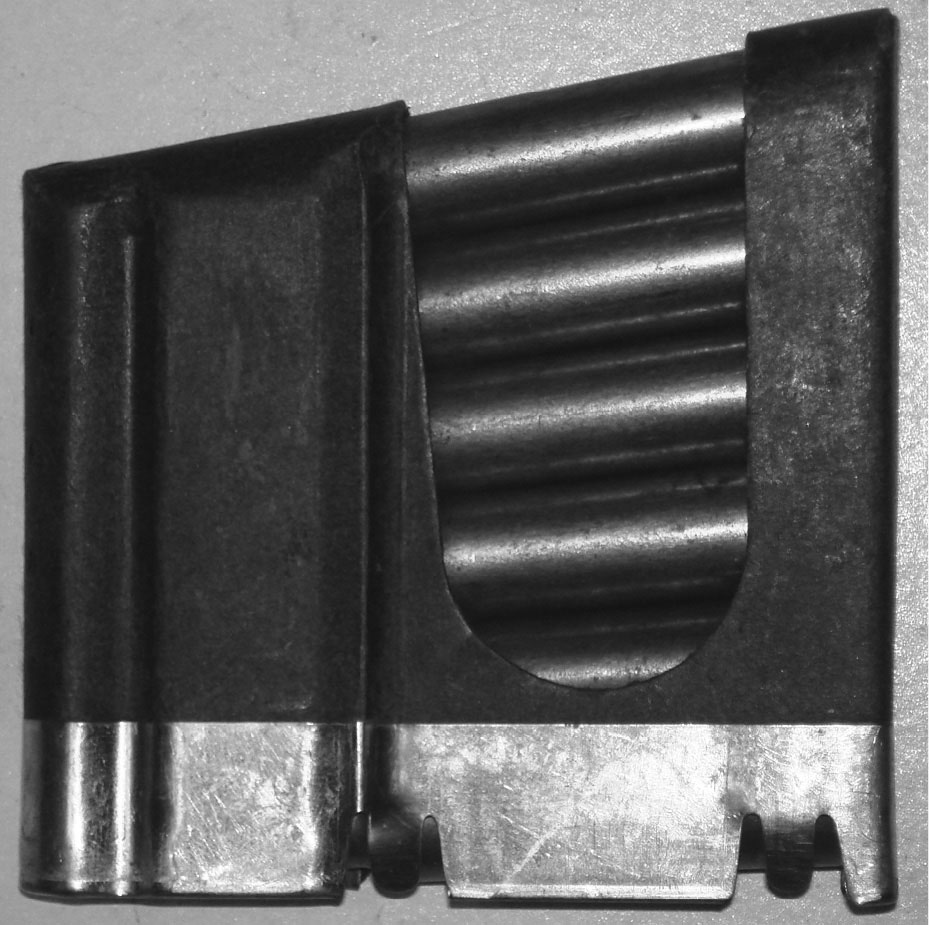
Charger clip for Schmidt Rubin rifles in 7.5×55mm. Price 10-4
Engineer Bayonet for Swiss M 1911 Carbine
Sometimes called a Pioneer bayonet. Wood handle. 18.75-inch single edge blade with saw teeth on the top. Very popular with collectors. Will also fit the K-31 short rifle. Does not fit the Schmidt Rubin long rifles as the muzzle opening is not large enough. Price range 175 – 75.
Bayonets for Schmidt Rubin Series
Wood grips. Muzzle ring. Bayonets made for the long rifles have a smaller muzzle opening than the carbines. 11.7" blade. The Model 1889 and 1911 versions have a single edge. They differ in the retaining ridge or stud in the fuller. The Model 1918 has a double edge. Makers name on the ricasso: Elsner Schwyz Victoria or Waffenfabrik Neuhausen. All use the same steel scabbard.
NOTE: The model 1918 is the correct bayonet for the K-31 rifle, although the other types fit as well. Price range 175 – 80.
Model 1931 Short Rifle K-31
Similar to the above, with a redesigned lock work, 25.7-inch barrel, and 6-shot magazine. This was the final version of the Schmidt-Rubin design. Instead of locking lugs into the receiver, the lugs were repositioned to lock into the receiver ring thereby greatly increasing the strength of the rifle. This change also increased the length of the barrel without increasing the overall length of the rifle. Approximately 528,180 were manufactured between 1933 and 1958. Many thousands were imported in the last few years. Note: Add $25-50 for a walnut stock.

Bayonets for Schmidt Rubin Series


Model K-31 with close-up of receiver markings • Courtesy Stoddard Martial collection, Paul Goodwin photo

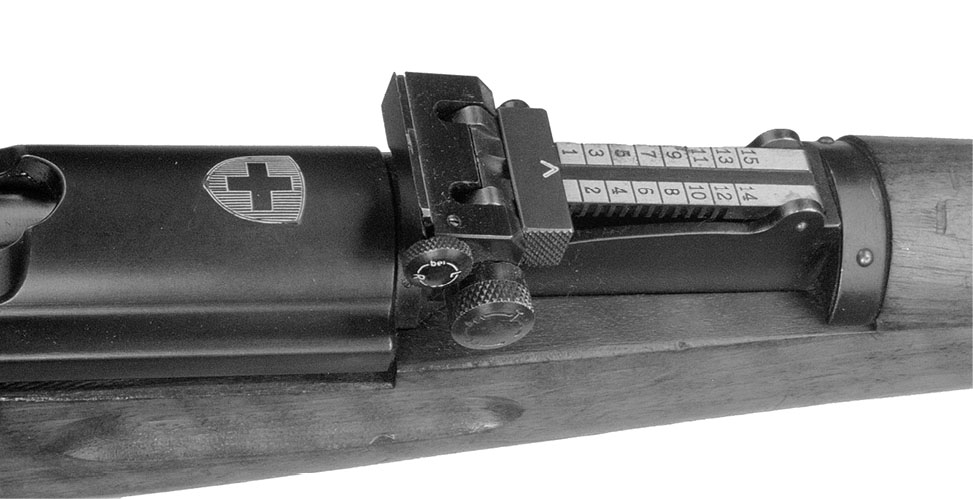

Model K-31 with shooter added sights • Courtesy Daniel Rewers collection, Paul Goodwin photo

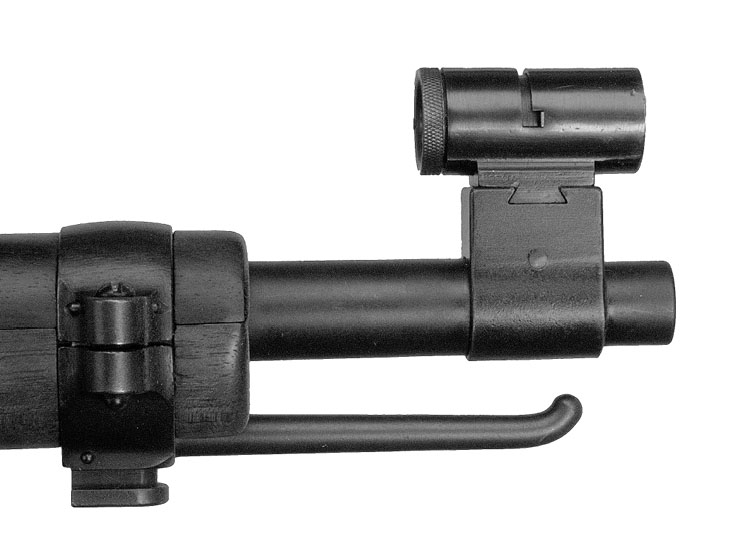

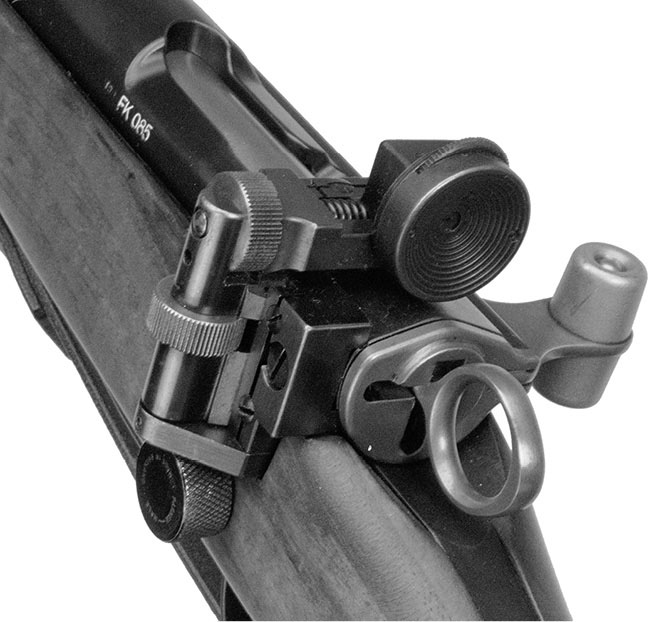
Hammerili Match K-31 with close-ups of receiver markings, and front and rear sights • Courtesy Daniel Rewers collection, Paul Goodwin photo



Model 1931 .22 training rifle. Close-up bolt shows it in the open and closed position • Courtesy Stoddard Martial collection, Paul Goodwin photo


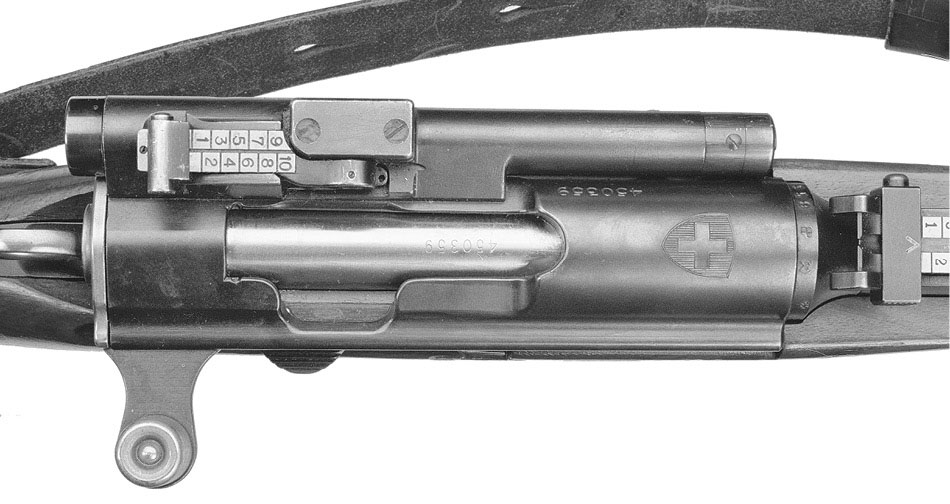
Model 1931/42 Rifle • Courtesy private NFA collection, Paul Goodwin photo
Exc. |
V.G. |
Good |
Fair |
400 |
300 |
250 |
125 |
Model 1931 Short Rifle with Shooter-Added Target Sights
Many shooters in Switzerland have modified Model 1931s with target sights. These can range in price due to the quality of the sights added. Prices range from $550 to $350.
Model 1931 .22 Target Rifle
This is the single-shot training version of the K31 with sights set for 50 meters.The rifle is the same overall length as the standard K31. Fitted with a highly modified bolt for the .22 caliber rimfire cartridge.
Exc. |
V.G. |
Good |
Fair |
950 |
750 |
600 |
350 |
Hammerili Match K31
This rifle is produced by Hammerili and is so marked on the receiver ring. These rifles have rear military sight omitted and a target sight installed at the rear of the receiver. Very limited production.
Exc. |
V.G. |
Good |
Fair |
4500 |
3750 |
3000 |
2000 |
There are a number of different sniper variants to the Model 1931 rifle. The first attempt was an experimental model, the Model 1940, fitted with a Wild & Gerber scope, which was positioned high above the receiver by means of an odd looking scope mount with a forehead protector attached to it. The second experimental model was the Model 1942 with a small detachable scope fitted to the left side of the receiver. All of these rifles were manufactured in small quantities.
Model 1931/42
Built by Waffenfabrik Bern on the Model 31 action and stock. Barrel length is 25.7 inches with 6-shot magazine. Walnut stock with handguard. This variant is fitted with a 1.8 power integral telescope attached to the left side of the receiver. It has a unique periscope type rotating objective. This rifle is also fitted with open sights to 1,500 meters.



Model K-31/43 Sniper rifle with close-up of scope location • Courtesy Daniel Rewers collection, Paul Goodwin photo
Exc. |
V.G. |
Good |
Fair |
4500 |
3500 |
2500 |
1000 |
Model 1931/43
As above but with a 2.8 power telescope.
Exc. |
V.G. |
Good |
Fair |
4500 |
3500 |
2500 |
1000 |


Model 1955 Rifle • Courtesy private NFA collection, Paul Goodwin photo
Model 1955
This model, introduced in 1955, is built on a Model 1931 action. Barrel length is 25.7 inches. A muzzle brake is fitted. This model is fitted with a 3.5 power Kern Aarau telescope mounted on the receiver bridge. Beechwood stock is 2/3 length with handguard and checkered pistol grip. Integral bipod built into midpoint of stock. Weight is about 12 lbs.
Exc. |
V.G. |
Good |
Fair |
4500 |
3500 |
2500 |
1000 |
Model 1893 Carbine
This is a Mannlicher straight-pull design carbine with a 21.5-inch barrel chambered for the 7.5×53.5mm cartridge. It was the only Mannlicher adopted by Switzerland. It was fitted with a full-length stock and upper handguard. No bayonet fittings. Magazine capacity was 6 rounds and it was charger loaded. The receiver ring is marked with a small Swiss cross.
Exc. |
V.G. |
Good |
Fair |
1000 |
800 |
650 |
350 |

Schweizerische Industrie Gesellschaft,
Neuhausen am Rheinfalls, Switzerland
SSG 2000
This is a high-grade, bolt action, sniping-type rifle chambered for .223, 7.5mm Swiss, .300 Weatherby Magnum, and .308 Winchester. It has a 24-inch barrel and was furnished without sights. It has a 4-round box magazine. The finish is matte blued with a thumbhole-style stippled walnut stock with an adjustable cheekpiece. This model was discontinued in 1986.
NIB |
Exc. |
V.G. |
Good |
Fair |
8000 |
6000 |
3500 |
1500 |
— |
SSG 3000
Chambered for the .308 Win. cartridge, this model is fitted with a 23.4-inch barrel and ambidextrous McMillian Tactical stock. Magazine capacity is 5 rounds. Overall length is 46.5 inches, and approximate weight is 12 lbs. This model comes in three different packages. They are listed below.


Mannlicher Model 1893 Carbine • Courtesy West Point Museum, Paul Goodwin photo

PE557 Assault Rifle • Courtesy Chuck Karwan
Level I
Base model with no bipod or scope, but with carrying case.
NIB |
Exc. |
V.G. |
Good |
Fair |
2600 |
2000 |
— |
— |
— |
Level II
At this level a Leupold Vari-X III 3.5-10×40mm Duplex scope and Harris bipod with carrying case.
NIB |
Exc. |
V.G. |
Good |
Fair |
3500 |
2750 |
— |
— |
— |
Level III
Rifle is supplied with a Leupold Mark 4 M1-10×40mm Mil-Dot Scope with Harris bipod and carrying case.
NIB |
Exc. |
V.G. |
Good |
Fair |
4500 |
3500 |
— |
— |
— |
SIG AMT
This is a semi-automatic rifle chambered for the 7.62 NATO cartridge. Fitted with a 19-inch barrel and wooden buttstock and forearm. Folding bipod standard. Box magazine capacity is 5, 10, or 20 rounds. Weight is about 10 lbs. Built from 1960 to 1974.
NIB |
Exc. |
V.G. |
Good |
Fair |
4500 |
3850 |
3250 |
2500 |
1500 |
SIG PE57
Similar to the above but chambered for the 7.5×55 Swiss cartridge.
NIB |
Exc. |
V.G. |
Good |
Fair |
4500 |
4100 |
3500 |
2700 |
1700 |
Bern Stg 51 Assault Rifle
Developed after the end of World War II; the Swiss wanted their own version of a true assault rifle. Waffenfabrik Bern was one of the companies involved in this project. The result was the Stg 51 first built in 1951. This rifle was chambered for the 7.5mm short cartridge, a special cartridge made specifically for this rifle and no longer produced. The rifle is select fire and does so in both models in closed-bolt position. A 30-round box magazine supplies the gun that has a rate of fire of about 800 rounds per minute. The barrel is 22.5 inches in length and is fitted with a muzzle brake/flash suppressor. A mid-barrel bipod is fitted just ahead of the forend. Weight is approximately 10.5 lbs.
A second model of this rifle was also produced with internal modifications and some small external differences. Both models were issued to the Swiss army, most likely on a trial basis. Extremely rare.


Swiss Stg Model 51 (2nd Model) • Courtesy private NFA collection, Paul Goodwin photo

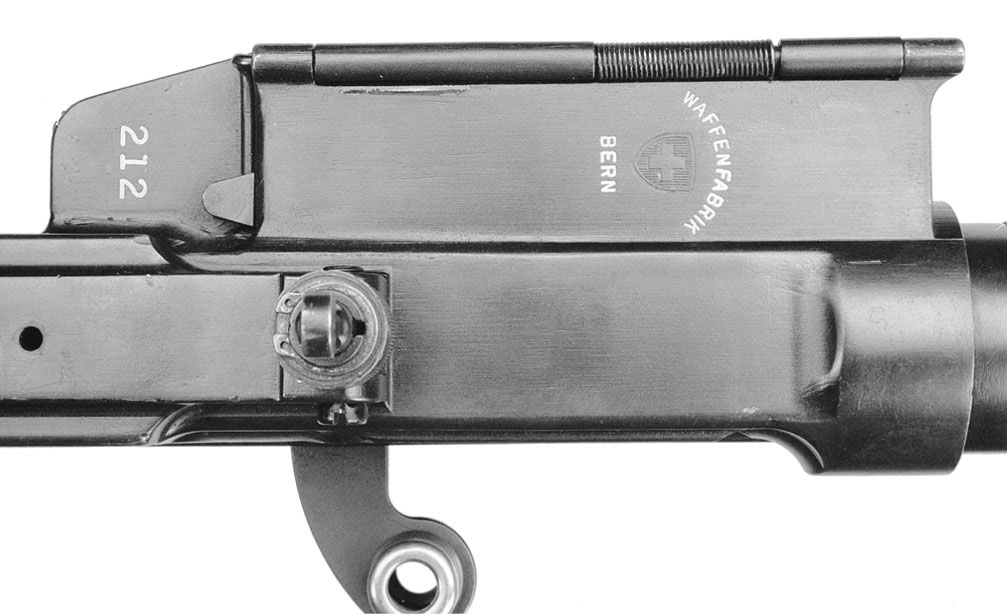
Swiss SIG Model 51 (2nd Model) • Courtesy private NFA collection, Paul Goodwin photo

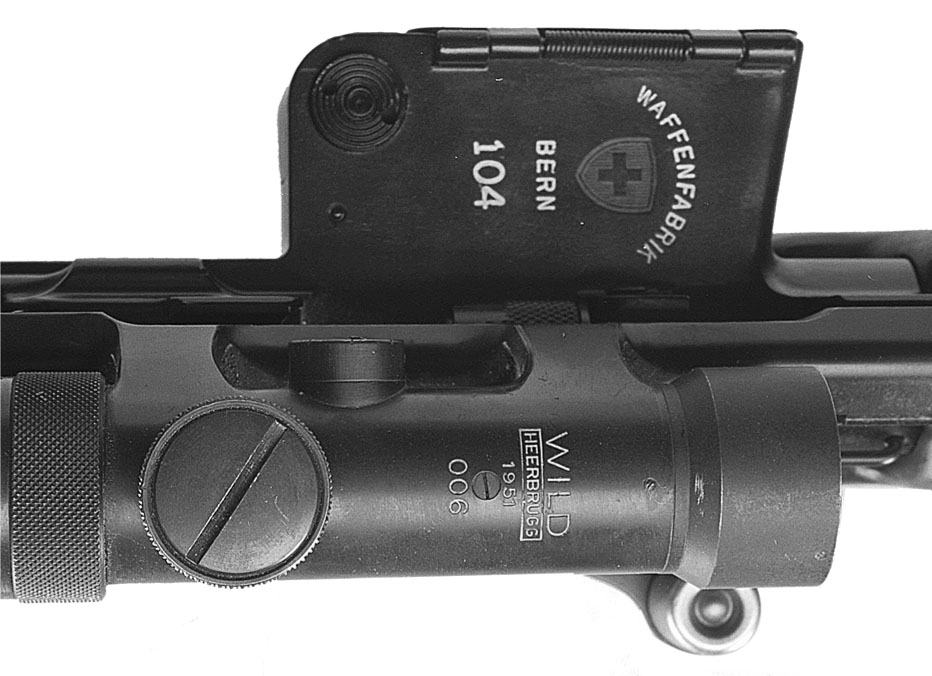
Bern Stg 54 • Courtesy private NFA collection, Paul Goodwin photo

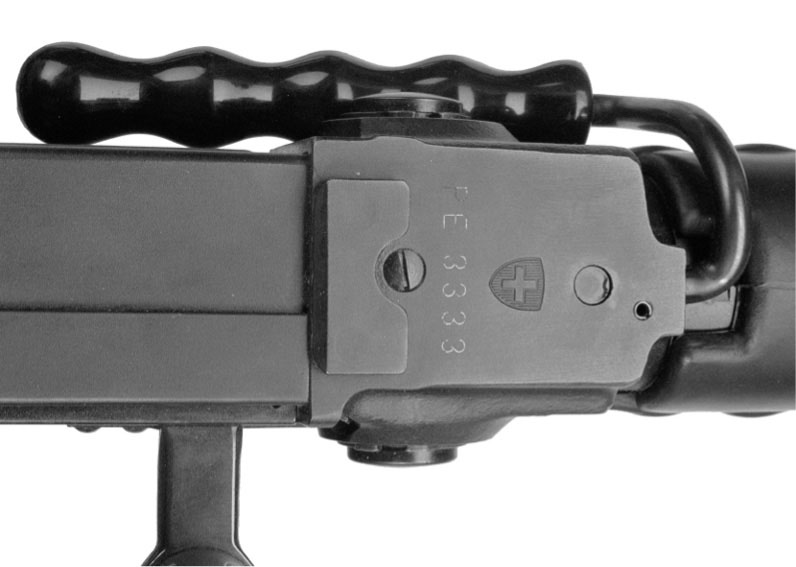
SIG Stgw 57 with close-up of receiver markings • Courtesy Stoddard Martial collection, Paul Goodwin photo
NOTE: The first model of this rifle will interchange some parts with the German FG 42. The second model will interchange all of its parts with the German FG 42.
Bern Stg 51 (First Model)
Pre-1968
Exc. |
V.G. |
Fair |
75000+ |
— |
— |
Bern Stg 51 (Second Model)
Pre-1968
Exc. |
V.G. |
Fair |
75000+ |
— |
— |
Bern Stg 54 (Sturmgewehr W+F 1954)
Introduced in 1954 and chambered for the 7.5mm cartridge, this assault rifle is fitted with a 28.4-inch barrel including muzzle brake. Weight is approximately 11 lbs. Rate of fire is about 800 rounds per minute. Select fire. Magazine capacity is 30 rounds. Fitted with a bipod. This was an experimental model and it was produced in a number of different variants. Extremely rare.
Pre-1968
Too Rare To Price.
SIG Stgw 57 Assault Rifle
This rifle is a select fire chambered for the 7.5×55mm Swiss cartridge. Barrel length is 23 inches. Box magazine capacity is 24 rounds. Weight is about 12.25 lbs. Adopted by the Swiss army with about 600,000 of these rifles produced between 1957 and 1983. It is based on the German StG 45. The rifle has a pressed steel receiver, folding bipod, wood butt, barrel jacket, and carry handle. The muzzle is designed to act as a grenade launcher and compensator. As with all standard issue Swiss military rifles, this rifle will remain in service for the lifetime of the soldier.
Pre-1968
Exc. |
V.G. |
Fair |
N/A |
N/A |
N/A |
Pre-1986 manufacture with new receiver or re-weld
Exc. |
V.G. |
Fair |
22000 |
20000 |
18000 |
Bayonet for STG 57
Molded plastic handle. 9.5-inch double edge blade. Price range 50 – 30.

Bayonet for STG 57
SIG 550
This semi-automatic rifle is chambered for .223 cartridge and fitted with an 18" barrel.

NIB |
Exc. |
V.G. |
Good |
Fair |
9000 |
7000 |
5500 |
3000 |
— |
SIG 551
Same as above but fitted with a 16-inch barrel.
NIB |
Exc. |
V.G. |
Good |
Fair |
9500 |
7500 |
6500 |
4000 |
— |
SIG SG510-4
There are actually four different versions of this rifle. This version fires the 7.62×51mm cartridge and is fitted with a 19.7-inch barrel. A military version, adopted by the Swiss army, is called the Stgw 57(510-1). Magazine capacity is 20 rounds. Weight is 9.3 lbs. Rate of fire is 600 rounds per minute. Produced from 1957 to 1983. Markings are on left rear of receiver.
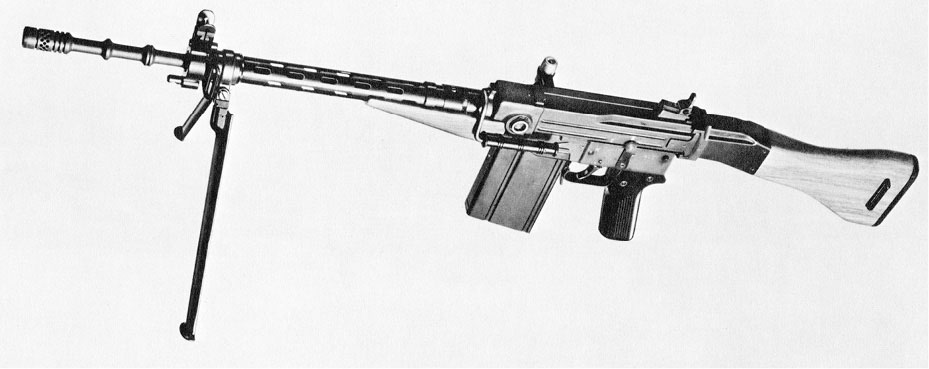
Pre-1968 (Rare)
Exc. |
V.G. |
Fair |
N/A |
N/A |
N/A |
Pre-1986 manufacture with new receiver or re-weld
Exc. |
V.G. |
Fair |
20000 |
18000 |
16000 |
SIG 530-1
This rifle is a scaled-down version of the Stgw 57 assault rifle chambered for the 5.56×45mm cartridge. Operated by a gas piston system instead of a delayed blowback operation. Receiver is pressed steel with synthetic butt and forend. Barrel is 18 inches in length with compensator and grenade launcher rings. Magazine capacity is 30 rounds. Weight is about 7.5 lbs. Rate of fire is 600 rounds per minute. There is also a folding stock version of this rifle.

Pre-1968
Exc. |
V.G. |
Fair |
N/A |
N/A |
N/A |
SIG SG540
Designed by the Swiss (SIG) and built in Switzerland, and also built in France by Manurhin beginning in 1977. This 5.56×45mm rifle is in service by a number of African and South American countries. It is fitted with an 18-inch barrel, 20- or 30-round magazine and has a rate of fire of 800 rounds per minute. It is fitted with a fixed stock. Its weight is 7.8 lbs. Marked “MANURHIN FRANCE SG54X” on right side of receiver. This rifle is still in production. There are also two other variants called the SG542 and SG543.
Pre-1968
Exc. |
V.G. |
Fair |
N/A |
N/A |
N/A |
Bayonet for SIG Model 530 and 540 Series
Plastic tubular handle that fits over the flash hider. 7-inch double edge blade. Plastic scabbard. Price range 175 – 75.
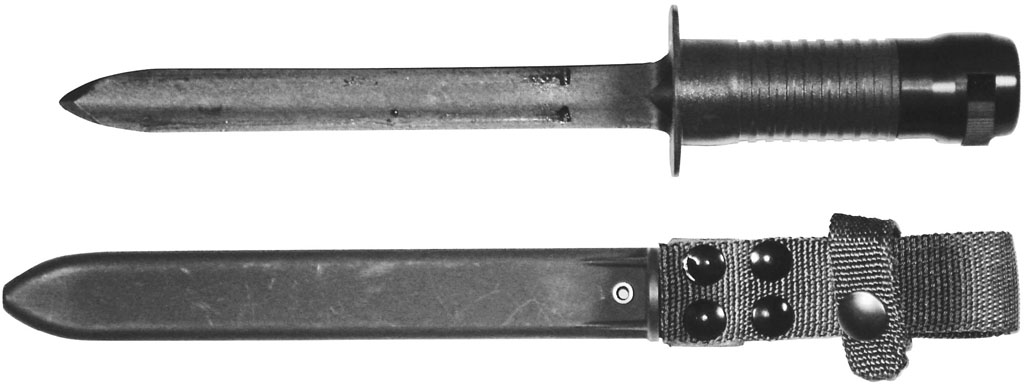
Bayonet for SIG Model 530 and 540 Series

The Swiss adopted the Maxim machine gun in 1894. The Swiss military also used the Maxim Model 1900. More recently the Swiss have used the FN MAG in addition to its own Swiss-built guns.


Swiss Model 1911 Maxim • Courtesy private NFA collection, Paul Goodwin photo
Model 1911 Maxim (MG11)
Built by W+F Bern and chambered for the 7.5×55mm Swiss cartridge. Fitted with a plain steel water jacket, otherwise identical to the German MG 08. This was the standard Swiss heavy machine gun and remained in service until 1951.

Furrer M25 Light • Courtesy private NFA collection, Paul Goodwin photo
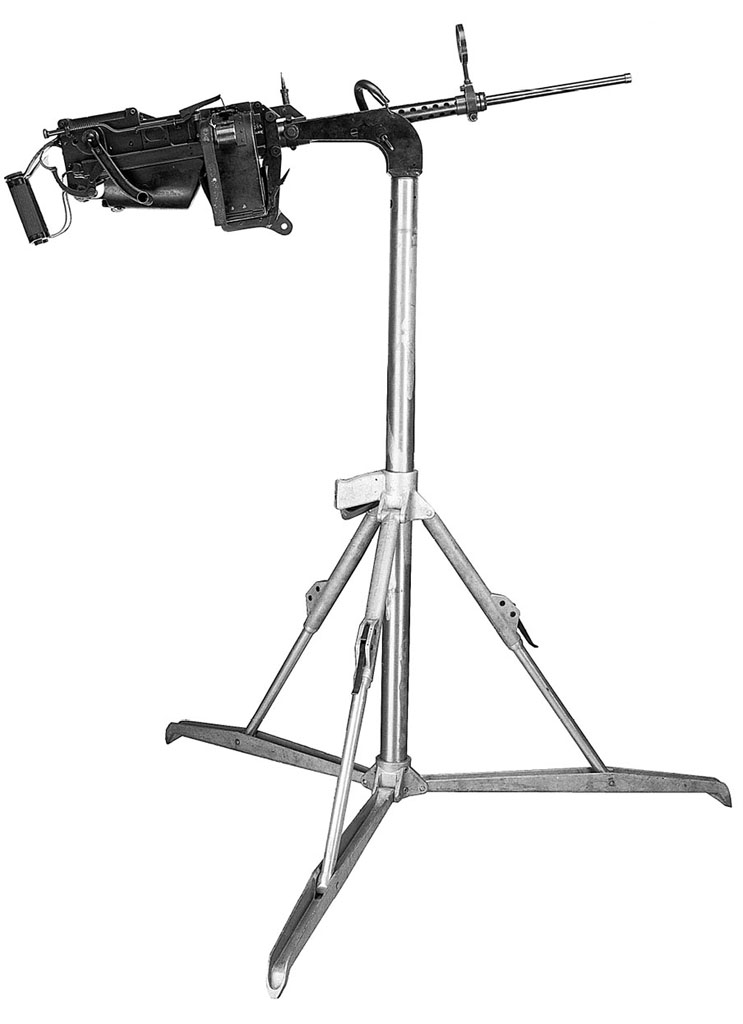
Swiss Flab MG29 with close-up of markings • Courtesy private NFA collection, Paul Goodwin photo
Pre-1968
Exc. |
V.G. |
Fair |
35000+ |
32500 |
30000 |
Pre-1986 manufacture with new receiver or re-weld
Exc. |
V.G. |
Fair |
20000 |
18000 |
16000 |
Model Flab MG29
Developed by Adolph Furrer and built in 1929 by W+F Bern, this machine gun was chambered for the 7.5mm Swiss cartridge. Fed by metal belts. It was designed for use on armored vehicles and for anti-aircraft applications. The gun has a high rate of fire of about 1,100 rounds per minute. Weight is about 20 lbs. Too rare to price.
Model 25 Light
Introduced in 1926, this gun was designed as a light air-cooled gun chambered for the 7.5×55mm Swiss cartridge. The gun uses a toggle action that opens sideways. It is fitted with a 23-inch barrel with slotted barrel jacket, flash hider, and bipod. The buttstock is wooden. The magazine is mounted on the right side of the gun and has a capacity of 30 rounds. Rate of fire is about 450 rounds per minute. Weight is approximately 24 lbs.
Pre-1968
Exc. |
V.G. |
Fair |
35000+ |
— |
— |